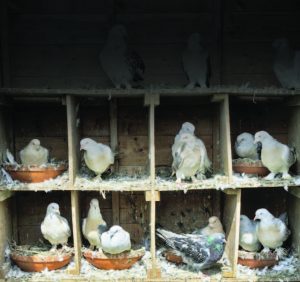Pigeons are said to be one of the oldest domesticated birds. They used to be a means of communication, carrying messages during the war. When the war ended, locals used them for more domestic tasks: delivering messages and sending small items.

However, as I went deeper into the hobby, I realized that I could enjoy taking care of racing pigeons even without participating in the sport.
The pigeons’ daily flight around my loft is a joy in itself. Their intelligence and personality give me additional reasons to enjoy their company.
Color-Coding
I consulted my ever-reliable Merriam Webster dictionary, and graphic artist and adviser Vanessa Estarija, to simplify my understanding of pigeon colors and patterns. The following are the terms most used in off-color pigeon racing discussions.

- Standard. This defines as an established criterion. Blue bar, black, and blue checkered make the local criteria. These are the three most popular colors and patterns.
- Solid. This refers to single colors, such as black, red, white, and yellow.
- Splash. A bird with a “splash” of colors is marked or overlaid with patches of contrasting color or texture.
- Pied. This refers to two or more colors in blotches. It also means having a parti-colored coat.
- Grizzle. The word refers to a “roan” coat pattern or color. Roan, according to Merriam Webster, means having the base color (such as red, black, or brown) muted and lightened by the admixture of white hairs.
- Slate. A dark purplish gray.
- Indigo. This is a deep purplish-blue color.
- Opal. Opal is a mineral with soft changeable colors that is used as a gem.
- Mealy. Flecked with another color; spotty, uneven, pallid, or blanched.
- Milky. This means a color or consistency resembles milk.
- Pattern. This terms refers to the regular and repeated way in which something is done.
- Saddle. This is a colored marking on the back of an animal.
- Ash. Shades of gray.
- Dun. This refers to a gray-gold or tan color.
- Andalusian. This means grey black.
- Almond. A color that is off-white brown in appearance.
- Khaki. Light yellowish-brown.
- Brown. This is a color resembling coffee or chocolate.
- Off-color. This means not having the right or standard color.
- Rare color. This refers to occasional occurrences.
Almost all types of pets boast of different colors and patterns. The variety gives us different ways to appreciate them.
Don’t Judge a Bird by Its Color
Locally bred, fancy, and imported racing pigeons are all the same to me. It is their distinct personality for which my fascination never fades.
Color genetics has been a fascination of mine. Color development, as an additional perk, will give fanciers more passion for pigeons. The short span of pigeon maturity makes creating beautiful colors easier.
But I always remind myself and others that what is more important than the beauty of our pets is the realization that they are not toys, nor are they to be merely displayed like artwork. They are creatures that provide companionship, joy, and connection. Our role is to be responsible in providing the best of care for them.
Taking Flight
Last year, I noticed people having a renewed fascination for pigeon racing, especially with what they called “off-color” or “rare-color” birds. This busted the myth that the high success rates of racing were attributable to blue bar and checkered pigeons only. All colors are now being raced, which makes the hobby even more popular.

As a non-racer fancier, I remember my childhood days and feel nostalgic about my admiration for pigeons of different colors and patterns. Nowadays, I have more fun as a fancier.
I noticed several terms in coloration appearing in social media groups. While these are interesting, they seem to make everything more complex. With other animals, most fanciers love to create different names for color mutations. This may make them look like more experienced hobbyists and help them increase the market value of animals, but I believe in keeping things simple.
This appeared in Animal Scene magazine’s October 2018 issue.






